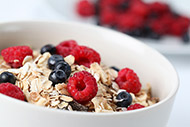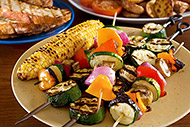
The fear of fruits and vegetables going to waste makes it challenging to keep the kitchen full of produce. Don’t be afraid to stock up during the next sale. There are many ways to preserve produce that will keep you eating nutritious fruits and vegetables year-round.
Dry and Dehydrate
Drying and dehydrating remove moisture from produce to prevent food spoilage. It provides a healthy way to turn fruits and vegetables into shelf-stable treats without added sugar and sodium. Electric food dehydrators dry foods quickly with circulating air at a temperature of 140°F. Fruits and vegetables can also be dried in the oven at the lowest temperature setting.
It may take some trial and error to dry produce in the oven successfully. Keep the oven door open, rotate pans occasionally, and watch the food closely to prevent scorching.
Apples, apricots, berries, pears, carrots, beets, greens, pumpkins, and tomatoes are all good options for drying and dehydrating.
Fruits and vegetables can be blended into purées and dried on sheet pans to make leathers that can be sliced and rolled for an easy snack.
Small whole fruits or fruits cut into thin slices dry more evenly. Toss the fruit in lemon juice to help prevent color changes during the drying process.
Vegetables dry well when cut into thin slices or small strips. Blanching (cooking vegetables in boiling water for two to five minutes and then submerging them in an ice bath until they are cool) before dehydrating will help soften the vegetables, promoting faster drying.
Foods must be completely dry to prevent spoilage during storage. Properly dried fruits and vegetables can be stored in airtight containers at room temperature for 6 to 12 months.
Freeze
Freezing is a healthy and convenient way to preserve produce, but there are some things to keep in mind to ensure you end up with a healthy and appealing product when it is defrosted.
Fruits and vegetables contain enzymes that change the flavor, color, and nutrients of produce. These enzymes can remain active even while the food is frozen. Blanching before freezing preserves quality by stalling the action of these enzymes while also killing any bacteria on the surface.
Remove all of the air from freezer bags to prevent oxidation and the development of off-flavors.
Freeze produce soon after purchase. The faster a food freezes, the better its quality will be once it defrosts. Avoid overloading your freezer with room-temperature foods, as this can prolong the freezing time.
Frozen foods should be stored at 0°F or lower. Most frozen fruits and vegetables can be stored for 8 to 12 months.
While most fruits and vegetables freeze well, the National Center for Home Food Preservation advises against freezing cabbage, celery, cucumbers, lettuce, parsley, and radishes. Their high water content leaves them mushy and unappetizing when defrosted.
Ferment
Fermented foods contain beneficial bacteria and enzymes that aid digestion. Cabbages and cucumbers are the most commonly fermented vegetables. According to Tufts University, fermenting cabbage to create sauerkraut and kimchi increases cancer-fighting glucosinolates. The downside of fermentation is that the process requires large amounts of salt. Be sure to limit your overall sodium intake on the days you enjoy fermented foods.
Store-bought fermented foods often undergo high-heat cooking and pasteurization, which kills the beneficial bacteria. By making your own fermented vegetables, you can preserve these healthy components.
The National Center for Home Food Preservation cautions against using untested and unapproved recipes when fermenting foods. Do not attempt to alter ingredients such as salt or vinegar. The correct balance of ingredients is necessary to prevent the growth of harmful bacteria.
Sources



 3 Healthy Lunches for Your Work Week
3 Healthy Lunches for Your Work Week
 5 Tips for Stretching Your Budget for Healthy Food
5 Tips for Stretching Your Budget for Healthy Food
 Best Ways to Reduce Added Sugar
Best Ways to Reduce Added Sugar
 Healthy Tips to Lighten Up Picnic Foods
Healthy Tips to Lighten Up Picnic Foods
 Do You Need to Drink Milk?
Do You Need to Drink Milk?
 Tips to Keep Track of Water Intake
Tips to Keep Track of Water Intake
 Butter vs. Margarine: What’s the Best Choice?
Butter vs. Margarine: What’s the Best Choice?
 7 Good Mood Foods
7 Good Mood Foods

 Pinterest
Pinterest RSS Feed
RSS Feed